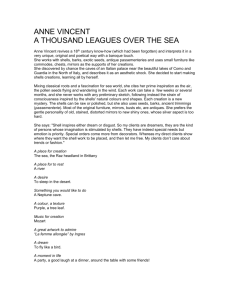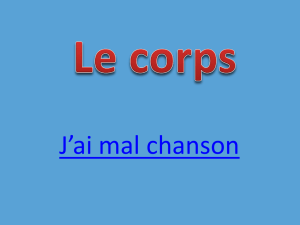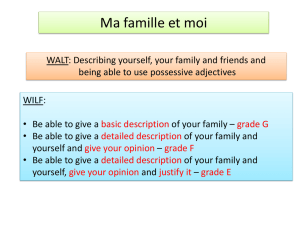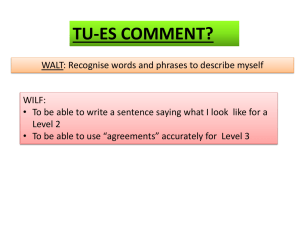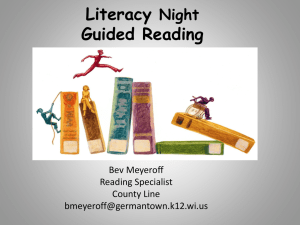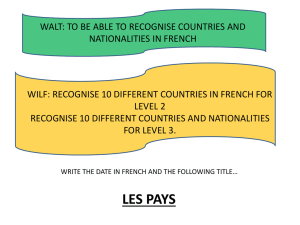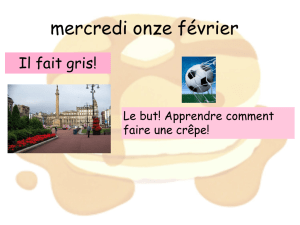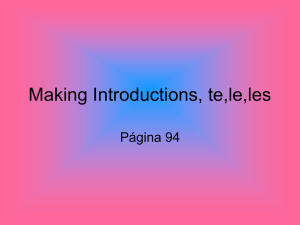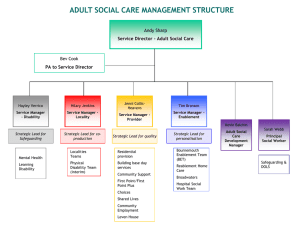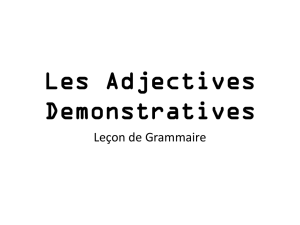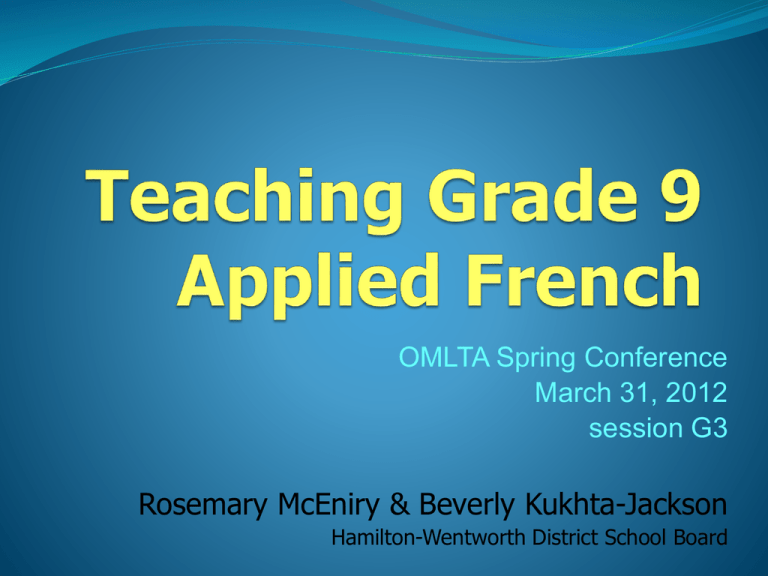
OMLTA Spring Conference
March 31, 2012
session G3
Rosemary McEniry & Beverly Kukhta-Jackson
Hamilton-Wentworth District School Board
Rose & Bev
•
Profile of students in our board
"Where we're coming from"
• largely urban/suburban with a smaller rural population
• 18 secondary schools with populations ranging from
approximately 500 to 1700 students
• Composite schools, academic, applied, locally
developed, French Immersion, International
Baccalaureate, Specialist High Skills Majors, etc.
Rose and Bev 's Specifics
• each over 20 years experience teaching Core and
Immersion French - applied and general and
academic, mostly secondary, some elementary
• Waterdown and Westdale are semestered
schools - 75 minute periods
• applied classes between 19 and 23 students
• programs used: Quoi de neuf? (Pearson),
Communi-Quete, Express 9e, Autour de Nous...
Audience profile
•
•
•
•
•
•
•
•
•
•
•
•
Quoi de Neuf
Communi-Quête
Autour de Nous
Passages
Tous Ensemble
Entre Amis
Voyages
D'Accord
Vive le Français
Passeport Français
Cours moyen de français
No textbook!
Who are the grade 9 applied
students? (interactive audience task)
• What is positive?
• What is less positive?
• What is interesting?
Who are the grade 9 applied students?
• What is positive?
(interactive audience task)
their energy
open to new things
real
learn more about sex
than I’ll ever know!!
hands-on – they get
involved
Be kind, be gentle.
Very enthusiastic – if
you can hook them.
know where you stand Teach other skills
– tell you the truth
while teaching
French.
creative
innocence
honesty
outgoing & accepting
of others
forces teacher to be
creative
Loyal – once they
trust you.
participate a lot
less inhibited
funny
willing to seek help
not to impress
smaller classes
You can help them see Needy. They need
that they can do it.
you.
Energetic!
Who are the grade 9 applied students?
What is less positive?
(interactive audience task)
behavioural problems
too wide a range of ability
IEPs
easily distracted
no writing utensils
very needy
Don’t value French.
lack of persistence
many have family/ personal
issues
harder to control/ stay
quiet
lose motivation quickly
You need to get & keep
their attention span which
equals that of an ant.
May take academic
everything else & become
distracting.
Brag about making
elementary teachers
miserable.
They “suck” the energy out
of you.
sometimes chronic
attendance problems
Difficult to motivate some.
varied language levels
work habits
weak learning skills
jaded language outlook
classroom management
weak language skills
Short attention span (can
be impatient)
Breaking the barrier of
negative past experiences.
sometimes poor
interpersonal skills
on toes all the time
Have to be sensitive.
attitude about French
Who are the grade 9 applied students?
What is interesting?
(interactive audience task)
Family struggles
?
Curriculum Tâche Finale –
Board game
no EAs to help
learning
disabilities
great imaginations and more
hands-on
teaching “life”
facts (for
example, what is a
leap year) =
greater interest
Enjoy the
French
activities.
Most do really well
when you remove the
focus on grammar &
re-focus on drama
(skits) and songs.
Their varied
interests.
Their sense of Teacher rarely gets bored.
humour.
Strategies for engagement
& enjoyment
• Structure of our classes
• seating, space, procedures and routines, rules
• Ambiance of the classroom
• Motivational tricks
• Break the lesson up to do different
activities/phases
(with a common focus to accomplish
learning goal of the day)
• Be flexible and not entirely predictable
Classroom routines and
organizational tips
• homework practices - reinforcement of class work, easy
•
•
•
•
enough to complete on own, puzzles, handouts, find information
(i.e. favourite food labels, what were you like as a small child)
assignments - rough work and editing in class, polished work
completed at home (helps avoid use of web translators). If use
web translators, must do again. Will not mark translations.
Finish project prior to test.
Reference sheets “cheat sheets” created by students can be
used for grammar quizzes and tests
Build in time/excuse to get out of seats sometime
during class every day.
Setting up the classroom
• stickers
• markers
• scissors
• chart paper
• coloured paper, cover stock, ledger size
• index cards
• wooden sticks (tongue depressors)
• lost and found pencils and pens
• And?...
Strategies used to engage students
and to enjoy spending time with them
• Sense of humour - Say it with a smile or a
twinkle in your eye.
• Differentiated instruction - limit choice to two or
three options.
• Show that you care.
• Be consistent, insistent and persistent.
Differentiated
Instruction
• 10 different ways of
making choices
• Choice of evaluation
10 different ways of
making choices
1. Choice of
topic/theme.
2. Choice of
environment.
3. Choice of text.
6. Choice to work
independently or with a
partner.
7. Choice of members of
group.
8. Choice of materials.
4. Choice of
9. Choice of seating.
questions.
5. Choice of activities. 10. Choice of time.
Integrating Technology
• Audacity
• SmartBoard
• XpressLab
• Senteo
• Smartphones and tablets
Integrating Technology
Web resources:
•Bon Patron
•Le Grand dictionnaire.com
•Twitter
•Blogspot
•Internet game sites
•Wordreference.com (on their smartphone)
•
•
•
•
•
BBC French (Ma France video program and activities)
Digital Dialects
Voki
comic strip creators i.e. BitStrips
PollEverywhere
Does anyone have a web site?
Games and communication activities
(Rose)
Vilain Lapin
Create a set of flash cards for the grammar point or vocabulary under
review. Make sure the flash cards are of the same size and either of a single
colour or a variety of colours as long as there are at least 4 or 5 cards of each
colour. In addition, create at least one or two “villain lapin” cards per 4 or
5 cards. Just draw a picture of a Bugs Bunny face to represent the “vilain lapin”.
These should be of the same colour as the other cards. Shuffle into the deck
randomly.
2. Split the students into two teams and line them up in a definite order. Show
the top card to the first team member. If they answer correctly, they score a
point. At this point, they can choose to “continue” or “arrête”. If they choose
“arrête” the opposing team takes over.
3. If a team is shown a “vilain lapin” card, they lose all their points and the
control goes immediately to the opposing team. This happens as well, if they
answer incorrectly.
4. Option: you can add “super lapin” bonus point cards to motivate if students
get discouraged losing all their points.
1.
Games and communication activities
(Rose)
Telephone
This is an excellent way to review a defined list of
vocabulary words at the end of a unit.
•Give each student a printout of a traditional telephone
keypad.
•“0” represents a space.
•The teacher spells out the vocabulary word in code using the
numbers on the key pad and the students write down the
word they think it is. (i.e. 76663 = pomme)
•Options: You can use double or triple numbers if the
students are having a difficult time coming up with the correct
corresponding letter (i.e. 1=a,11=b, 111=c)
•You can have students create the codes and they must read
aloud the numbers in French.
Games and communication activities
(Rose)
Order of Direct and Indirect Object Pronoun
Substitutions and Sentence Word (pg.1 of 2)
Materials:
•Write sentences which contain direct objects and/or indirect object
nouns and the different verb tenses which have been taught.
•Cut up sentences into flash cards with one word per card.
•Make identical sets for each team which you create.
•Create a separate set of flashcards which contain only the
direct object pronouns and/or indirect object pronouns.
Again make duplicates to match the number of teams which have
been created.
Games and communication activities
Order of Direct and Indirect Object Pronoun Substitutions
and Sentence Word (pg. 2 of 2)
Game
Divide class into teams…or call upon team leaders to create the teams. A team should consist
of 6 to 8 persons. Each team must select a leader. Can have more than 2 teams.
Have each team select one of its members to leave the room with a flash card set of
direct and/or indirect object pronouns. Hence each team has selected one of its own
members to leave the room.
At the same time, distribute to the team leader of each team an identical set of sentence
flashcards which have been shuffled and have them distribute the cards to their team
members.
The first team to place themselves in the correct sentence order (holding up their
flashcards for you to see) scores a point.
You can have each group read their sentence out loud if you want.
Next, call in the pronoun objects that have left the room.
They must find the direct or indirect object in the sentence, remove that person or
persons, and then position themselves correctly before the verb in the sentence.
The first team to do this correctly, scores again.
You can have teams facing each other and do not go to the next sentence until you see all
teams standing in the correct order.
Games and communication activities
(Rose)
Qui est l’intrus?
Find a suitable photo of a group of 5 or 6 people and make a copy for each group.
Make an envelope for each group with the following texts:
(on outside of envelope)
Michel a invité 5 amis à sa fête d’anniversaire mais il y a 6 personnes dans la photo. Qui est l’intrus?
A tour du rôle, chaque membre du groupe va lire la description d’une des personnes dans la photo. Les
autres membres du groupe doit identifier cette personne dans la photo. Le but est de découvrir
l’intrus.
(in envelope cut into separate pieces – one per description)
Je m’appelle Raymond. J’ai les cheveux très courts parce que j’ai souvent chaud. J’aime porter les
vêtements confortables même en hiver. Je suis de taille moyenne mais très forte. Ma peau est un peu
sombre. J’aime la couleur verte.
Je m’appelle Julien. Je suis grand et même un peu gros. J’ai les cheveux qui deviennent chauves. J’ai
besoin de lunettes pour lire. Je travaille dans un bureau avec beaucoup de jeunes personnes.
Je m’appelle Céline. Je suis toujours souriante. Mes parents viennent du Japon mais je suis née ici en
Amérique du nord. J’ai les cheveux noirs que j’aime porter en queue de cheval.
Mon nom est Naomi. Je suis de taille moyenne et j’ai les cheveux noirs. J’ai la peau sombre. Parfois je
suis un peu trop sérieuse.
Je m’appelle Raoul. Je suis un peu plus grand que ma petite amie à ma gauche. J’ai les cheveux bruns et
j’ai une petite barbe au visage. Je ne vois pas très bien donc je dois porter des lunettes.
Games and communication
activities
Le Jeu des Horoscopes (pg. 1 of 4)
1. Place in the centre of each table 5 labelled envelopes:
ville, résidence, colocataire, nombre d’enfants, voiture.
(see pg. 2 of 4 of this section of
PowerPoint for ideas)
1. Each envelope should contain at least the same number of items as
members of the group. (see pg. 3 of 4 of this section of PowerPoint for ideas)
2. In a clockwise manner, take turns drawing one item from each
category to create the horoscope for the person on your right.
3. Use the handout “Ton horoscope” to prepare the horoscope you will
say to the person to your right. (see pg. 4 of 4 of this section of PowerPoint for a template)
4. All verbs must be in the futur simple. The subject pronoun is “tu”.
5. Orally take turns reading/saying out loud the horoscopes to one
another.
6. Now each person writes down their own horoscope under the heading
Mon Horoscope taking notes from the person to their left as they say it.
This time the subject pronoun is “je”. (see pg. 4 of 4 of this section of PowerPoint for template)
Games and communication activities
Le Jeu des Horoscopes (pg. 2 of 4)
Labels for envelopes
Ville
Résidence
Colocataire
Voiture
Nombre
d’enfants
Games
and communication
Le Jeu des Horoscopes
activities
(pg. 3 of 4)
Samples of cards to put in each envelope
Ville
Résidence
Colocataire
Nombre
d'enfants
Véhicule
Toronto
Une maison de
ville
Brad Pitt
1
Dodge
Caravan
Vancouver
Un voilier
Angelina Jolie
2
Mazda Protégé
Halifax
Un condominium
Paris Hilton
3
Nissan
Maxima
Calgary
Un appartement
Jennifer
Aniston
4
Honda Accord
Edmonton
Une maison
détachée
Tom Cruise
5
Ford Focus
Games and communication activities
Le Jeu des Horoscopes (pg. 4 of 4)
Handout for each student
Ton Horoscope
Tu vivras à __________________ (ville).
Tu vivras dans ________________ (résidence).
Tu habiteras avec __________________ (colocataire).
Tu auras __________________ enfant(s).
Tu conduiras une __________________.
Mon Horoscope
Je vivrai à _______________.
Je __________________________________
Je __________________________________
Je _________________________________
Je __________________________________
Games and communication activities
Les livrets (folding books - Bev)
http://library.thinkquest.org/J001156/makingbooks/minibook/index.htm
http://www.makingbooks.com/hotdog.shtml
•Theme: Ma journée d’hier
•Create sentences together on board or overhead or
computer or chart paper.
Fold paper in half 3 times and cut middle section,
then re-fold in booklet form.
Students write title and name on front page, then
choose 6 or 7 sentences that describe their day (one
per page). They draw simple images or use photos or
clip art to illustrate each sentence.
•
•
Games and communication activities
(Bev)
Making a restaurant
•Students create menus or signs.
•Bring in tablecloths, flowers, candles, table settings.
•Use real menus and other props (i.e. order pad).
•Use LCD projector or overhead transparency to create a
backdrop.
Give the students a reference sheet with useful phrases
and vocabulary to create their dialogue (i.e. Chat Boosters
by Sue Fenton).
Encourage the students to wear appropriate clothing.
Decide role – maybe at last minute by drawing a card.
•
•
•
Games and communication activities
Presentations
(Bev)
•Allow time to practice in class with partners and in
small groups.
Assign practicing at home - ask them to keep track of
how many times they rehearse and encourage use of
live audience and recording self .
Allow final rehearsal in class then have them present
to you at your desk or a "presentation corner" instead
of for the whole class. Give all students a puzzle or
worksheet.
Consider using technology i.e. iPod to record and
submit.
•
•
•
Games and communication activities
(Bev)
Other fun stuff
FOOD!!!
Crêpes
Vin faux, Vrai fromage
Dégustation du chocolat
Le comparatif/ le superlatif
Les pommes rouges, vertes, jaunes
Autre fruits
Les bonbons
Les croissants, le pain au chocolat, une baguette…
Success vs. Survival
• Sometimes success is survival.
• Student success versus teacher
success.
• Take care of yourself.
Success = Positive attitude
• I can’t believe class is over already!
• I just realized that I actually look
forward to this class.
• Can we have more of that cheese?
• I still don’t like French, but I like you.
• This is the first time in 3 years that I
have passed French.
• Look! I did my homework!
la fin!!
rosemary.mceniry@hwdsb.on.ca
beverly.kukhta-jackson@hwdsb.on.ca
also: Twitter (Bev) search by email address
and: Bev’s blog: www.ms-k-j.blogspot.com (this is aimed at students and parents)

